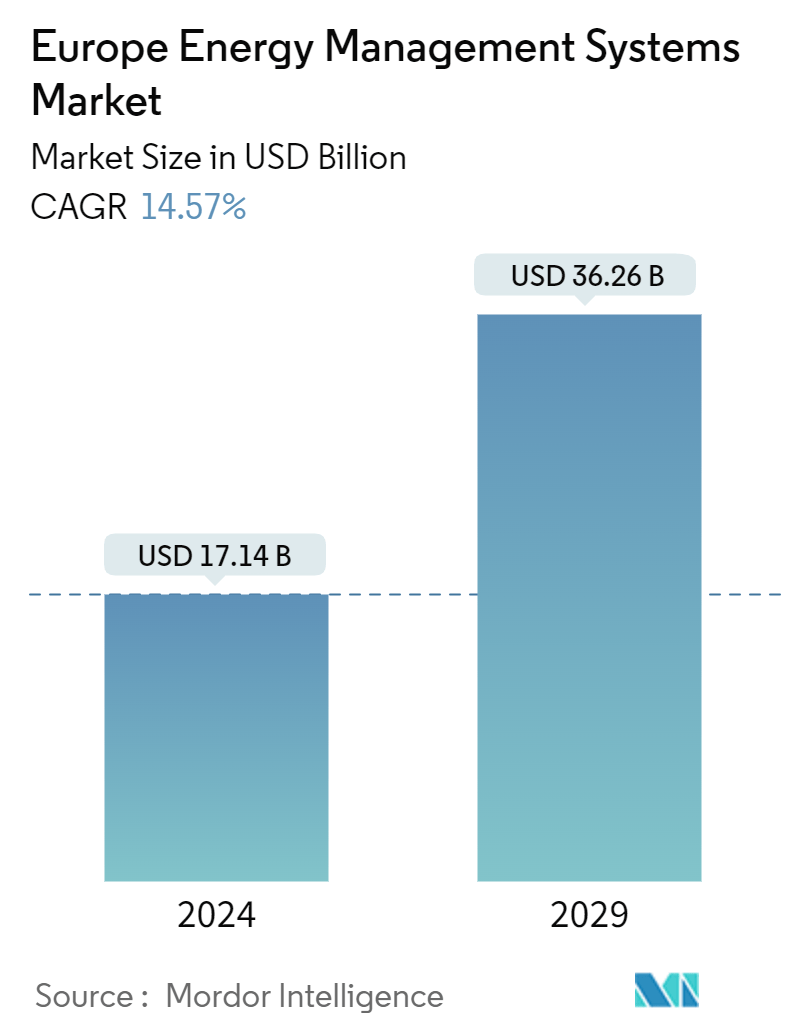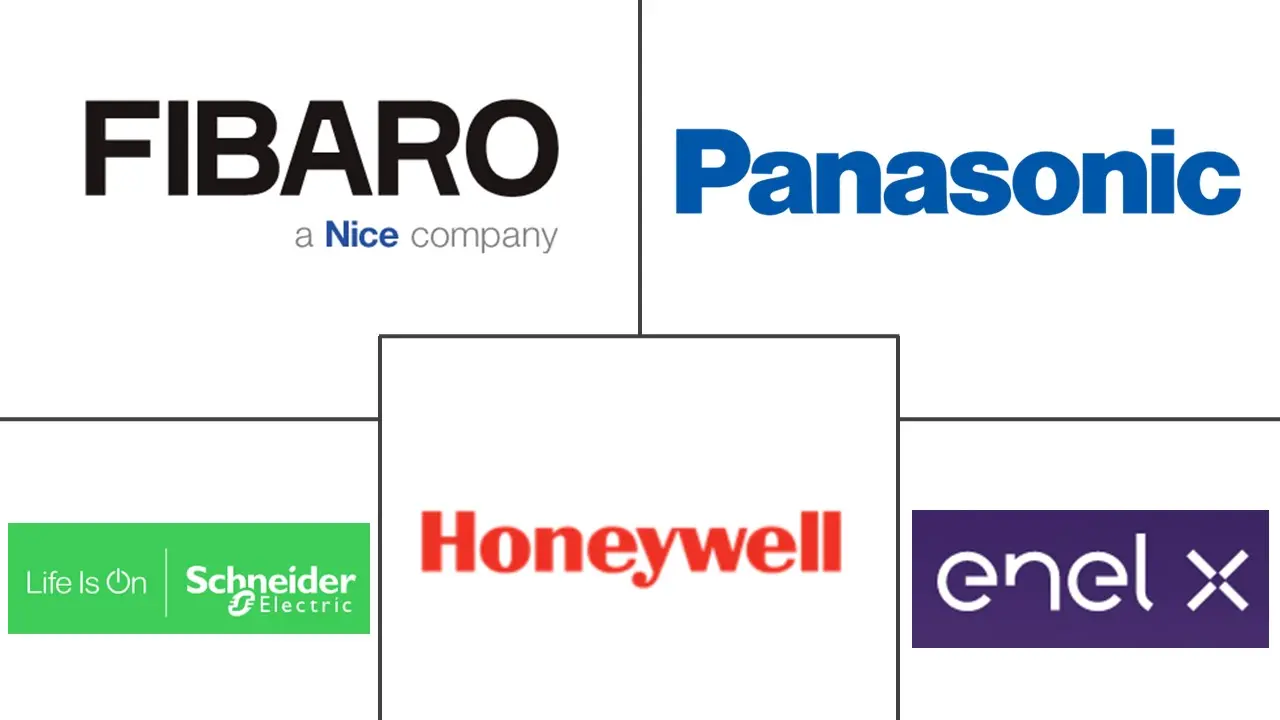Market Size of Europe Energy Management Systems Industry

| Study Period | 2019 - 2029 |
| Base Year For Estimation | 2023 |
| Market Size (2024) | USD 17.14 Billion |
| Market Size (2029) | USD 36.26 Billion |
| CAGR (2024 - 2029) | 14.57 % |
| Market Concentration | High |
Major Players
*Disclaimer: Major Players sorted in no particular order |
Europe Energy Management Systems Market Analysis
The Europe Energy Management Systems Market size is estimated at USD 17.14 billion in 2024, and is expected to reach USD 36.26 billion by 2029, growing at a CAGR of 14.57% during the forecast period (2024-2029).
- Smart Grid Revolution Drives Market Growth: The Europe Energy Management Systems (EMS) market is undergoing significant expansion, driven by the adoption of smart grid technologies and smart meters. These innovations are transforming the energy sector, with substantial investments being made to modernize grids across Europe.
- Smart grid investment: Investment in Europe’s smart grid infrastructure reached USD 56.7 billion in 2021, showing notable growth from USD 48.7 billion in 2017.
- Smart meter adoption: The European Union aims to install 225 million smart electricity meters and 51 million gas meters by 2024, with 80% of consumers targeted to be equipped with smart meters.
- UK smart meter installations: In Great Britain, the number of smart meters installed by large energy suppliers surged from 135,090 in Q2 2020 to 979,752 in Q2 2021, reflecting rapid adoption rates.
- Energy Efficiency Takes Center Stage: Rising investments in energy efficiency are fueling the demand for EMS solutions as governments and businesses recognize the benefits of optimized energy use.
- EU energy efficiency target: The European Union has set a goal of increasing energy efficiency by at least 32.5% by 2030, driving demand for energy-efficient solutions.
- Germany’s efficiency drive: Germany aims to cut primary energy consumption by 30% by 2030 compared to 2008, pushing demand for advanced EMS technology.
- Turkey’s efficiency investments: Turkey plans to invest over USD 10 billion in energy efficiency over the next decade, with projected savings of USD 30 billion by 2033.
- HVAC Demand Surges Amid Population Growth: Demand for Heating, Ventilation, and Air Conditioning (HVAC) systems is growing rapidly, driven by population increases and changing climate conditions, creating a new market for EMS providers.
- Population growth: Europe’s population grew to 743.5 million in 2022, up by 4.6 million since 2012, increasing demand for new housing and HVAC systems.
- HVAC demand: The demand for air conditioning devices in Europe hit 8.9 million units in 2021, with Russia leading in sales at 1.9 million units.
- New HVAC plant investment: Mitsubishi Electric Corporation invested USD 113 million in a new air-conditioner production plant in Turkey, boosting production capacity by 100,000 units annually.
- Competitive Landscape Shapes Market Dynamics: The European EMS market is highly competitive, with both established players and startups working to gain market share.
- Key market players: Leading companies include Schneider Electric SE, Honeywell International Inc., Panasonic Corporation, and Enel X S.r.l.
- Schneider Electric's dominance: With 135,000 employees, Schneider Electric leads in providing comprehensive energy management software.
- Emerging players: Startups such as Green Energy Options Limited and Efergy Technologies S.L. are gaining traction in the residential EMS market with in-home energy monitoring devices.
- Future Outlook: Integration and Innovation: The future of Europe’s EMS market looks bright, with technological advancements and integration with other smart systems expected to drive further growth.
- Energy storage growth: The European Union’s energy storage capacity is expected to reach 187 GW by 2030 and 600 GW by 2050, necessitating advanced EMS solutions.
- AI and machine learning adoption: AI and machine learning are poised to enhance EMS capabilities, as countries like France invest EUR 2.2 billion in AI strategies.
- Distributed energy systems: The shift towards decentralized energy and increasing adoption of renewable energy will require sophisticated EMS to manage more complex energy ecosystems.
Europe Energy Management Systems Industry Segmentation
The Energy Management System (EMS) is a tool for monitoring, analyzing, and optimizing the operation of the electric transmission system. The system is widely used in various industries, and EMS implementation includes SCADA, Automatic Generation Control (AGC), and alarms, among others.
The Europe energy management systems market is segmented by type of solution (building energy management systems [hardware, software, and services], by end-user [commercial, healthcare, education, industrial, and other end-users], home energy management systems [hardware, software]), by distribution channel (direct/partner sales/retail, value-added resellers/system integrators, consultants/utilities), by country (United Kingdom, Germany, France, Spain, Benelux, and the rest of Europe). The report offers market forecasts and size in value (USD) for all the above segments.
| By Type of Solution | |||||||
| |||||||
| |||||||
|
| By Distribution Channel | |
| Direct/Partner Sales/Retail | |
| Value-added Resellers/System Integrators | |
| Consultants/Utilities |
| By Country | |
| United Kingdom | |
| Germany | |
| France | |
| Spain | |
| Benelux | |
| Rest of Europe |
Europe Energy Management Systems Market Size Summary
The European energy management systems market is experiencing significant growth, driven by the increasing demand for smart meters and investments in smart grid and building technologies. Energy management systems (EMS) play a crucial role in optimizing the operation of electric transmission systems, offering automated solutions that enhance efficiency and reduce costs. Despite challenges such as limited capital investment and infrastructure in emerging regions, the market is poised for expansion due to the deployment of advanced wireless technologies and the adoption of Industry 4.0. The healthcare sector, particularly in Germany, is witnessing a digital transformation with initiatives aimed at improving energy efficiency in hospitals, aligning with the country's climate goals. Programs like the "Green Hospital" and projects by the German Energy Agency are fostering the integration of energy management systems in healthcare facilities, creating opportunities for market players.
Germany's commitment to sustainable energy and the Energiewende initiative are central to the country's energy policies, promoting the use of renewable sources and smart technologies. The German government aims to significantly reduce primary energy consumption and greenhouse gas emissions, with healthcare facilities playing a vital role in these efforts. The European market is characterized by fragmentation, with numerous established vendors competing through product innovations and strategic partnerships. Companies like Schneider Electric, Honeywell, and Eaton are actively expanding their offerings and collaborating on projects to enhance energy management solutions. Recent developments, such as Honeywell's sustainability solution and Schneider Electric's home energy management system, highlight the ongoing advancements in the market, driven by the need for energy efficiency and sustainability across various sectors.
Europe Energy Management Systems Market Size - Table of Contents
-
1. MARKET INSIGHTS
-
1.1 Market Overview
-
1.2 Technological Advancements
-
1.3 Impact of Macro-economic Factors on The Market
-
1.4 Industry Attractiveness - Porter's Five Forces Analysis
-
1.4.1 Bargaining Power of Suppliers
-
1.4.2 Bargaining Power of Buyers
-
1.4.3 Threat of New Entrants
-
1.4.4 Threat of Substitutes
-
1.4.5 Degree of Competition
-
-
1.5 Industry Supply Chain Analysis
-
-
2. MARKET SEGMENTATION
-
2.1 By Type of Solution
-
2.1.1 Building Energy Management System
-
2.1.1.1 Hardware
-
2.1.1.2 Software and Services
-
-
2.1.2 By End-User
-
2.1.2.1 Commercial
-
2.1.2.2 Healthcare
-
2.1.2.3 Education
-
2.1.2.4 Industrial
-
2.1.2.5 Other End-Users
-
-
2.1.3 Home Energy Management System
-
2.1.3.1 Hardware
-
2.1.3.2 Software
-
-
-
2.2 By Distribution Channel
-
2.2.1 Direct/Partner Sales/Retail
-
2.2.2 Value-added Resellers/System Integrators
-
2.2.3 Consultants/Utilities
-
-
2.3 By Country
-
2.3.1 United Kingdom
-
2.3.2 Germany
-
2.3.3 France
-
2.3.4 Spain
-
2.3.5 Benelux
-
2.3.6 Rest of Europe
-
-
Europe Energy Management Systems Market Size FAQs
How big is the Europe Energy Management Systems Market?
The Europe Energy Management Systems Market size is expected to reach USD 17.14 billion in 2024 and grow at a CAGR of 14.57% to reach USD 36.26 billion by 2029.
What is the current Europe Energy Management Systems Market size?
In 2024, the Europe Energy Management Systems Market size is expected to reach USD 17.14 billion.

